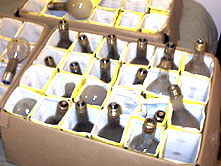 page 1 | 2
page 1 | 2
Driving downtown one rainy Sunday, I passed around the back of Sacramento's historic Memorial Auditorium. I spotted three big boxes of lightbulbs at the top of the dumpster and pulled over to take a look. There were 72 bulbs. They were large bulbs: 300-watts, with a magnum base. I half-expected the bulbs to be working, because rarely do two bulbs burn out at the same time, but they had all expired. I loaded the boxes into my trunk.
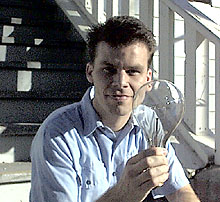 James at work told me these bulbs looked like PS35s. In lightbulb terms, that is for "Pear Shaped" size 35 (measured in 8ths of an inch).
James at work told me these bulbs looked like PS35s. In lightbulb terms, that is for "Pear Shaped" size 35 (measured in 8ths of an inch). 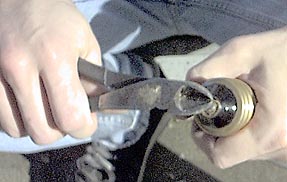 When I was a kid, my father showed my brother and I how to crush the base of a lightbulb and use the glass bulb like a chemistry-set flask. I decided I could break open the bulbs and create some kind of art-project out of them.
When I was a kid, my father showed my brother and I how to crush the base of a lightbulb and use the glass bulb like a chemistry-set flask. I decided I could break open the bulbs and create some kind of art-project out of them.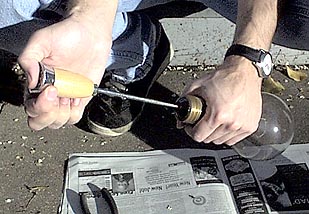 The first step was to pry off the metal contact at the very bottom of the base. I did that with wire-cutters. Next I used an ice pick to stab down the center of the bulb. This broke the sealing glass, and released the vacuum. I could usually hear it hiss for a second as air rushed into the bulb.
The first step was to pry off the metal contact at the very bottom of the base. I did that with wire-cutters. Next I used an ice pick to stab down the center of the bulb. This broke the sealing glass, and released the vacuum. I could usually hear it hiss for a second as air rushed into the bulb. 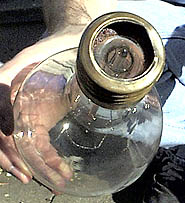 With a break in the base, I pried away the dark glass at the bottom and slid a metal rod into the bulb. By carefully pulling the filament armature to one side, it would break off without shattering the bulb, leaving a little pile of glass and wire inside.
With a break in the base, I pried away the dark glass at the bottom and slid a metal rod into the bulb. By carefully pulling the filament armature to one side, it would break off without shattering the bulb, leaving a little pile of glass and wire inside.
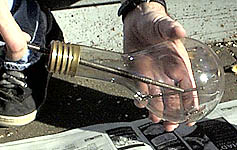
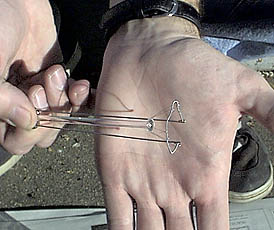
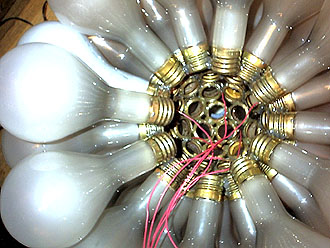 I did this about 50 times. I used the empty bulbs to fashion an ultra-fragile chandelier that recalls cell division and the 1970s. If all the bulbs were operating, it would use 15,000 watts.
I did this about 50 times. I used the empty bulbs to fashion an ultra-fragile chandelier that recalls cell division and the 1970s. If all the bulbs were operating, it would use 15,000 watts.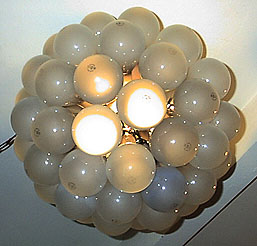
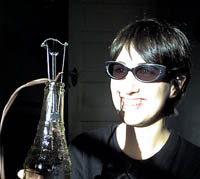 A few of the dissected lightbulbs had the filaments intact, so we decided to see how long one could incandesce out of a vacuum...sort of like Edison's experiments in reverse. The filament is a tight coil of a tungsten alloy, strong but brittle. I hooked up a stripped electrical cord to the ends of the filament and got the camera ready. Mike moved back, commenting that the wire is so bright because it is white-hot. This prompted Brooke and I to hunt around the lab for our tinted safety goggles.
A few of the dissected lightbulbs had the filaments intact, so we decided to see how long one could incandesce out of a vacuum...sort of like Edison's experiments in reverse. The filament is a tight coil of a tungsten alloy, strong but brittle. I hooked up a stripped electrical cord to the ends of the filament and got the camera ready. Mike moved back, commenting that the wire is so bright because it is white-hot. This prompted Brooke and I to hunt around the lab for our tinted safety goggles. With everything in place, we plugged it into the wall. It was awesome! It seemed supernaturally bright, but I suppose it was no brighter than a regular 300-watt bulb.
With everything in place, we plugged it into the wall. It was awesome! It seemed supernaturally bright, but I suppose it was no brighter than a regular 300-watt bulb.
Please continue reading page 2.

